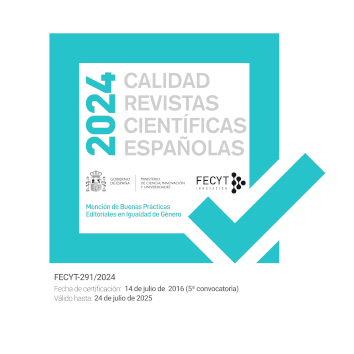Connecting the human and non-human in ICT class: scenarios feared by future teachers in Early Childhood Education
DOI:
https://doi.org/10.17398/1695-288X.17.2.25Keywords:
Educacional Technology, Emotional Development, Corporal Expression, Art Education, Preservice Teacher EducationAbstract
Teachers in initial formation need to acquire an emotional education that supports them in their professional development. Among the possible emotions that they may have, are the fears of different situations that may occur at an educational centre. Thus, this article presents a training experience using body language, artistic expression and ICT as resources that promote the emotional self-knowledge of university students. The research enabled the analysis, following a case study method with 71 university students and three professors of the subject ICT applied to Education, of how future teachers in Early Childhood Education face the fears, they have, of situations that can occur in school, through the use of ICT, body language and artistic expression. Among other results, students valued the importance of working their fears for their future teaching activity, (re) presenting feared scenes related to the dynamics within the classroom, such as the classroom control; and with those that happen outside of class, for example, mobbing. In addition, there was also a satisfaction among the teachers for breaking the stereotype of the instrumentalist class. The students, on their behalf, advised this workshop to be done in other subjects of the Degree and suggested that these dynamics be included throughout the course as they seemed beneficial for their training.
Downloads
References
Cope, B., y Kalantzis, M. (2010). Ubiquitous learning. Urbana and Chicago: University of Illinois.
Cuesta, S. M. (2015). Una propuesta didáctica para contribuir al desarrollo de la expresión de ideas y sentimientos de los alumnos de secundaria a través de la Educación Artística. Tesis doctoral. Universidad Complutense de Madrid.
Escandell, L. (2017). Recursos TIC para la educación emocional. En Agustín Caruana y Natalia Albaladejo (Eds.), Emociones en Secundaria, AEMO (pp. 61-70). Alicante: Generalitat Valenciana.
Eslava, C., y Cabanellas, M. I. (2005). Territorios de la infancia: diálogos entre la arquitectura y pedadogía. Graó.
Fernández, M. R., Palomero, J. E., y Teruel, M. P. (2009). El desarrollo socioafectivo en la formación inicial de los maestros. REIFOP, 12(1), 33-50.
Fernández, I. (2017). La gamificación: una herramienta para la educación emocional. En Agustín Caruana y Natalia Albaladejo (Eds.), Emociones en Secundaria, AEMO (pp. 49-56). Alicante: Generalitat Valenciana.
Gaggianesi, A., y Prieto, E. (2000). Los saberes corporales, lúdicos y motores en la formación docente. Gobierno de la Ciudad de Buenos Aires. Secretaría de Educación.
AUTORES (AÑO). TÍTULO.
Gruber, H., y Oepen, R. (2018). Emotion regulation strategies and effects in art-making: a narrative synthesis. Arts in Psycotherapy, 59, 65-74. DOI: 10.1016/j.aip.2017.12.006
Gutiérrez, A. (2003). Alfabetización digital: algo más que ratones y teclas. Barcelona: Gedisa.
Kirk, D. (2007). Con la escuela en el cuerpo, cuerpos escolarizados: la construcción de identidades internacionales en la sociedad postdisciplinaria. Ágora para la Educación Física y el Deporte, 4, 39-56.
Krason, K. (2017). The theater of movement in Primary School education. In 11th Conference on Technology, Education and Development (INTED). Valencia, Spain.
Liu, M.C., Huang, Y. M., y Xu, Y. H. (2018). Effects of individual versus group work on learner autonomy and emotion in digital storytelling. Educational Technology Research and Development, 66(4), 1009-1028. doi: 10.1007/s11423-018-9601-2
López, J. C. (2012). Identificación y regulación de emociones con Scratch. En José Hernández, Massimo Pennesi, Diego Sobrino y Azucena Vázquez (Eds.), Tendencias emergentes en educación con TIC (pp. 67-83). Barcelona: Espiral.
Moreno, C. (2014). Nuevos métodos en la Educación Artística. Experiencias docentes con metaeducarte. Historia y Comunicación Social, 19(2), 145-159. http://dx.doi.org/10.5209/rev_HICS.2014.v19.45017
Patton, M. Q. (2015). Qualitative research and evaluation methods. Beverly Hills, CA: Sage.
Polkinghorne, D. E. (2005). Language and meaning: data collection in qualitative research. Journal of Counseling Psychology, 52(2), 137–145. doi:10.1037/0022-0167.52.2.137
Quintero, L. E., Jiménez, F., y Area, M. (2016). Las “e-actividades”: aplicaciones y recursos web. Tándem: Didáctica de La Educación Física, 53, 12–18.
Retana-Alvarado, D. A., de las Heras, M. A., Vázquez-Bernal, B., y Jiménez-Pérez, R. (2018). El cambio en las emociones de maestros en formación inicial hacia el clima de aula en una intervención basada en investigación escolar. Revista Eureka sobre Enseñanza y Divulgación de las Ciencias, 15(2), 2602. doi:10.25267/Rev_Eureka_ensen_divulg_cienc.2018.v15.i2.2602
Ruano, K. (2013). El despertar de las emociones. Un trabajo corporal. Multiárea: revista de Didáctica, 6, 311-352.
Ruiz, M. A. (2011). Experiencias de corporeidad en escuela primaria. Una narrativa corporal desde la perspectiva de los sujetos. Tesis doctoral. Universidad de Barcelona.
AUTORES (AÑO). TÍTULO.
Stake, R. (2005). Multiple Case Study Analysis. New York: The Guilford Press.
Torrents, C., Mateu, M., Planas, A., y Dinusova, M. (2011). Posibilidades de las tareas de expresión corporal para suscitar emociones en el alumnado. Revista de Psicología del Deporte, 20(2), 401-412.
Twidale, M. B. (2010). From ubiquitous computing to ubiquitous learning. In B. Cope y M. Kalantzis (Eds.), Ubiquitous Learning (pp. 3–14). Urbana and Chicago: University of Illinois Press.
Downloads
Published
Issue
Section
License
Authors who publish in this journal accept the following conditions:
1. The Author retains copyright in the article. Upon acceptance of the article, the author shall grant to the Publisher the right of first publication of the article. with the dcoument registered with the Creative Commons Attribution-NonCommercial-NoDerivative 4.0 International (CC BY-NC-ND) license, which allows to third parties to use what is published whenever they mention the authorship of the work and the first publication in this journal.
2. Authors can make other independent and additional contractual agreements for the non-exclusive distribution of the article published in this journal (eg, include it in an institutional repository or publish it in a book) provided they clearly indicate that the work was published for the first time in this journal.
3. Authors are allowed and recommended to publish their work on the Internet (for example on institutional or personal pages) before and during the review and publication process, as it can lead to productive exchanges and a greater and faster diffusion of published work (see The Effect of Open Access).









